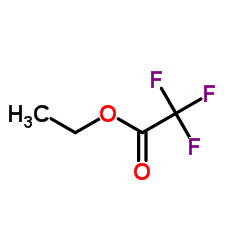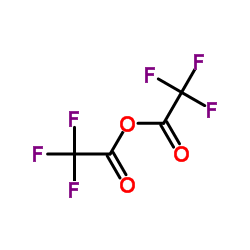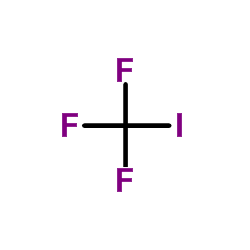Mercuric trifluoroacetate
Modify Date: 2024-01-04 16:57:02

Mercuric trifluoroacetate structure
|
Common Name | Mercuric trifluoroacetate | ||
|---|---|---|---|---|
| CAS Number | 13257-51-7 | Molecular Weight | 426.62100 | |
| Density | N/A | Boiling Point | 72.2ºC at 760mmHg | |
| Molecular Formula | C4F6HgO4 | Melting Point | 171-173ºC | |
| MSDS | Chinese USA | Flash Point | N/A | |
| Symbol |



GHS06, GHS08, GHS09 |
Signal Word | Danger | |
| Name | Mercuric trifluoroacetate |
|---|---|
| Synonym | More Synonyms |
| Boiling Point | 72.2ºC at 760mmHg |
|---|---|
| Melting Point | 171-173ºC |
| Molecular Formula | C4F6HgO4 |
| Molecular Weight | 426.62100 |
| Exact Mass | 427.94100 |
| PSA | 52.60000 |
| LogP | 1.10990 |
| Vapour Pressure | 96.2mmHg at 25°C |
| Water Solubility | soluble |
Synonym:Trifluoroacetic acid, mercury(II) sal Section 2 - COMPOSITION, INFORMATION ON INGREDIENTS
Risk Phrases: 26/27/28 33 Section 3 - HAZARDS IDENTIFICATION EMERGENCY OVERVIEW
Very toxic by inhalation, in contact with skin and if swallowed. Danger of cumulative effects.Hygroscopic (absorbs moisture from the air). Potential Health Effects Eye: Causes eye irritation. Skin: Causes skin irritation. Ingestion: May cause liver and kidney damage. May cause perforation of the digestive tract. May cause vascular collapse and damage. Causes severe pain, nausea, vomiting, diarrhea, and shock. May cause central nervous system effects. Inhalation: Causes respiratory tract irritation. May cause effects similar to those described for ingestion. Chronic: Prolonged or repeated inhalation of dusts may cause neurological damage. May cause liver and kidney damage. May cause reproductive and fetal effects. May cause tremors, irritability, loss of memory and intellect. May also cause Pink disease characterized by skin, cardiovascular, and neurobehavioral abnormalities. Section 4 - FIRST AID MEASURES Eyes: Immediately flush eyes with plenty of water for at least 15 minutes, occasionally lifting the upper and lower eyelids. Get medical aid. Skin: Get medical aid immediately. Immediately flush skin with plenty of water for at least 15 minutes while removing contaminated clothing and shoes. Ingestion: SPEED IS ESSENTIAL. A DOCTOR MUST BE NOTIFIED AT ONCE. Wash mouth out with water. Inhalation: Remove from exposure and move to fresh air immediately. If not breathing, give artificial respiration. If breathing is difficult, give oxygen. Notes to Physician: Section 5 - FIRE FIGHTING MEASURES General Information: As in any fire, wear a self-contained breathing apparatus in pressure-demand, MSHA/NIOSH (approved or equivalent), and full protective gear. Extinguishing Media: Use water spray, dry chemical, or carbon dioxide. Section 6 - ACCIDENTAL RELEASE MEASURES General Information: Use proper personal protective equipment as indicated in Section 8. Spills/Leaks: Vacuum or sweep up material and place into a suitable disposal container. Section 7 - HANDLING and STORAGE Handling: Do not get in eyes, on skin, or on clothing. Do not ingest or inhale. Do not allow contact with water. Use only in a chemical fume hood. Storage: Store in a cool, dry place. Store in a tightly closed container. Poison room locked. Section 8 - EXPOSURE CONTROLS, PERSONAL PROTECTION Engineering Controls: Facilities storing or utilizing this material should be equipped with an eyewash facility and a safety shower. Use process enclosure, local exhaust ventilation, or other engineering controls to control airborne levels. Exposure Limits CAS# 13257-51-7: United States OSHA: 0.1 mg/m3 Ceiling (listed under Mercury, ary and inorganic compounds). Belgium - TWA: (listed as mercury, aryl and inorganic compounds): mg/m3 VLE (as Hg) France - VME: (listed as mercury, aryl and inorganic compounds): mg/m3 VME (as Hg) Germany: (listed as mercury, aryl and inorganic compounds): 0.1 m VME (as Hg) Malaysia: (listed as mercury, aryl and inorganic compounds): 0.1 mg/m3 TWA (as Hg) Spain: (listed as mercury, aryl and inorganic compounds): 0.1 mg/ VLA-ED (as Hg) Personal Protective Equipment Eyes: Wear appropriate protective eyeglasses or chemical safety goggles as described by OSHA's eye and face protection regulations in 29 CFR 1910.133 or European Standard EN166. Skin: Wear appropriate protective gloves to prevent skin exposure. Clothing: Wear appropriate protective clothing to prevent skin exposure. Respirators: Follow the OSHA respirator regulations found in 29 CFR 1910.134 or European Standard EN 149. Use a NIOSH/MSHA or European Standard EN 149 approved respirator if exposure limits are exceeded or if irritation or other symptoms are experienced. Section 9 - PHYSICAL AND CHEMICAL PROPERTIES Physical State: Solid Color: slightly yellow Odor: Not available. pH: Not available. Vapor Pressure: Not available. Viscosity: Not available. Boiling Point: @ 760.00mm Hg Freezing/Melting Point: 171 - 173 deg C Autoignition Temperature: Not available. Flash Point: Not available. Explosion Limits, lower: Not available. Explosion Limits, upper: Not available. Decomposition Temperature: Solubility in water: Specific Gravity/Density: Molecular Formula: C4F6O4Hg Molecular Weight: 426.61 Section 10 - STABILITY AND REACTIVITY Chemical Stability: Stable under normal temperatures and pressures. Conditions to Avoid: None reported. Incompatibilities with Other Materials: Strong oxidizing agents. Hazardous Decomposition Products: Carbon monoxide, carbon dioxide, hydrogen fluoride gas, mercury/mercury oxides. Hazardous Polymerization: Will not occur. Section 11 - TOXICOLOGICAL INFORMATION RTECS#: CAS# 13257-51-7 unlisted. LD50/LC50: Not available. Carcinogenicity: Mercuric trifluoroacetate, 98% - Not listed by ACGIH, IARC, or NTP. Section 12 - ECOLOGICAL INFORMATION Section 13 - DISPOSAL CONSIDERATIONS Dispose of in a manner consistent with federal, state, and local regulations. Section 14 - TRANSPORT INFORMATION IATA Shipping Name: MERCURY COMPOUND, SOLID, N.O.S. Hazard Class: 6.1 UN Number: 2025 Packing Group: II IMO Shipping Name: MERCURY COMPOUND, SOLID, N.O.S. Hazard Class: 6.1 UN Number: 2025 Packing Group: II RID/ADR Shipping Name: MERCURY COMPOUND, SOLID, N.O.S. Hazard Class: 6.1 UN Number: 2025 Packing group: II Section 15 - REGULATORY INFORMATION European/International Regulations European Labeling in Accordance with EC Directives Hazard Symbols: T+ Risk Phrases: R 26/27/28 Very toxic by inhalation, in contact with skin and if swallowed. R 33 Danger of cumulative effects. Safety Phrases: S 13 Keep away from food, drink and animal feeding stuffs. S 28A After contact with skin, wash immediately with plenty of water. S 36 Wear suitable protective clothing. S 45 In case of accident or if you feel unwell, seek medical advice immediately (show the label where possible). WGK (Water Danger/Protection) CAS# 13257-51-7: No information available. Canada None of the chemicals in this product are listed on the DSL/NDSL list. CAS# 13257-51-7 is not listed on Canada's Ingredient Disclosure List. US FEDERAL TSCA CAS# 13257-51-7 is not listed on the TSCA inventory. It is for research and development use only. SECTION 16 - ADDITIONAL INFORMATION N/A |
| Symbol |



GHS06, GHS08, GHS09 |
|---|---|
| Signal Word | Danger |
| Hazard Statements | H300 + H310 + H330-H373-H410 |
| Precautionary Statements | Missing Phrase - N15.00950417-P260-P262-P280-P302 + P352 + P310-P304 + P340 + P310 |
| Personal Protective Equipment | Eyeshields;Faceshields;full-face particle respirator type N100 (US);Gloves;respirator cartridge type N100 (US);type P1 (EN143) respirator filter;type P3 (EN 143) respirator cartridges |
| Hazard Codes | T+:Verytoxic;N:Dangerous for the environment; |
| Risk Phrases | R26/27/28;R33;R50/53 |
| Safety Phrases | S13-S28-S36-S45-S60-S61 |
| RIDADR | UN 2025 |
| WGK Germany | 3 |
| Packaging Group | II |
| Hazard Class | 6.1 |
| HS Code | 29159080 |
| HS Code | 2915900090 |
|---|---|
| Summary | 2915900090 other saturated acyclic monocarboxylic acids and their anhydrides, halides, peroxides and peroxyacids; their halogenated, sulphonated, nitrated or nitrosated derivatives VAT:17.0% Tax rebate rate:9.0% Supervision conditions:AB(certificate of inspection for goods inward,certificate of inspection for goods outward) MFN tariff:5.5% General tariff:30.0% |
|
Hara, S. et al.
Synlett , 411, (1999)
|
| EINECS 236-250-4 |
| mercury trifluoro-acetate |
| mercury diselenocyanate |
| MFCD00013201 |
 CAS#:383-63-1
CAS#:383-63-1 CAS#:407-25-0
CAS#:407-25-0 CAS#:2314-97-8
CAS#:2314-97-8 CAS#:937-44-0
CAS#:937-44-0